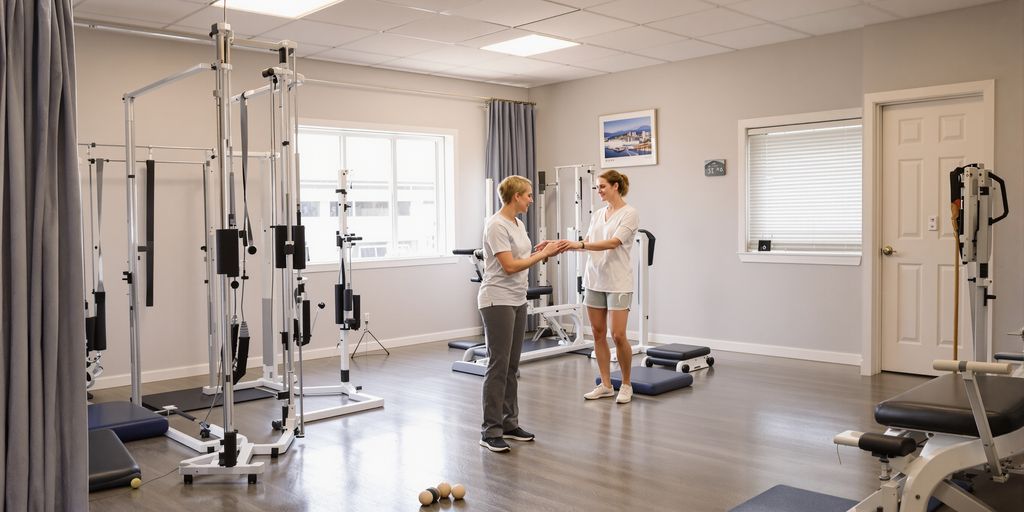Understanding Vestibular Therapy: A Comprehensive Guide
Discover effective vertigo therapies to regain balance and control. Explore exercises, advanced treatments, and lifestyle changes for relief.


Feeling that dizzy, spinning sensation can really throw you off balance, can't it? Vertigo therapy offers a path toward feeling more stable and in control. You don't have to just live with that unsettling feeling. There are many ways to approach vertigo, from simple exercises to more involved treatments. This guide looks at different vertigo therapy options that can help you find some much-needed relief.
Key Takeaways
- Understanding the root cause of your vertigo is the first step toward effective treatment.
- Vestibular rehabilitation exercises and balance training are core components of many Vertigo therapy plans.
- Lifestyle changes, like diet and stress management, can significantly support your recovery.
- Advanced therapies such as hyperbaric oxygen therapy and neurofeedback may offer additional benefits for some individuals.
- A personalized Vertigo therapy approach, developed with your healthcare team, is vital for lasting relief.
Understanding Your Vertigo
Feeling dizzy or like the room is spinning can be really unsettling. This sensation, known as vertigo, can make everyday activities feel challenging and throw off your sense of balance. It's not just a feeling of being unsteady; it's often a sign that something is affecting your inner ear or the parts of your brain that control balance.
What Causes Vertigo?
Vertigo itself isn't a disease, but rather a symptom. The most common reason for this feeling is an issue with your inner ear, which plays a big role in keeping you balanced. Sometimes, tiny crystals in your inner ear can get out of place, sending confusing signals to your brain. Other times, it might be related to problems in your neck and spine, as nerves that help with balance run through these areas. It's important to figure out what's causing your specific vertigo so you can get the right help.
The Dizzying Sensation Explained
When you experience vertigo, it can feel like you're moving when you're actually still, or like the world around you is tilting or spinning. This can lead to a feeling of being off-kilter, making it hard to walk straight or even stand without feeling wobbly. Your brain receives signals about balance from your inner ear, eyes, and body. When these signals don't match up, you feel dizzy. This mismatch can happen for various reasons, but the result is that confusing, spinning sensation that defines vertigo.
Key Vertigo Therapy Techniques
When you're dealing with vertigo, getting your body moving in the right ways can make a big difference. These techniques focus on retraining your balance system and easing physical tension that might be contributing to your dizziness.
Vestibular Rehabilitation Exercises
These are special exercises designed to help your brain learn to compensate for problems in your inner ear or the parts of your brain that handle balance. They often involve specific head and eye movements. For example, you might be asked to focus on a still object while moving your head, or to follow a moving object with your eyes. The goal is to help your brain get better at processing balance information and reduce the feeling of spinning. Consistency is key with these exercises.
Balance Training for Stability
Improving your balance is key to feeling more secure. Balance training involves exercises that challenge your stability in safe ways. This could mean standing on one foot, walking heel-to-toe, or using a wobble board. The more you practice these, the better your body gets at making quick adjustments to stay upright. It's like teaching your body to be more aware of where it is in space.
Manual Therapy for Neck and Spine
Sometimes, issues in your neck and spine can affect your balance and even cause dizziness. This is because nerves that help with balance run through these areas. Manual therapy, like gentle adjustments or massage, can help release tension in your neck and upper back. This can improve blood flow and nerve function, which may lessen vertigo symptoms. Think of it as helping to unblock any physical road bumps that might be affecting your inner ear signals.
Building Trust in Your Body's Movement
When you have vertigo, it's common to feel like your body is playing tricks on you. That sense of unsteadiness can make you doubt your own movements. Rebuilding trust in your body is a big part of getting better. It's about teaching your brain that moving can feel safe again.
Relearning Safe Movement
This often involves doing gentle, controlled movements. Think of it like slowly showing your brain that it can rely on your body's signals. Therapies that focus on balance and coordination are really helpful here. They help your brain and body work together more smoothly, so you can feel more confident moving around.
Gaining Confidence Through Therapy
As you practice these exercises and techniques, you'll start to notice improvements. Each small success builds on the last, helping to restore your confidence. It's a process, and being patient with yourself is key. You're retraining your body and brain to work in harmony, which can significantly reduce that feeling of being off-balance.
Creating Your Personalized Therapy Plan
Finding the right way to manage your vertigo is like putting together a puzzle, but it doesn't have to be confusing. Your path to feeling better is unique, and your treatment plan should be too. It's about picking the pieces that fit your specific situation best. Think of it as creating your own map, not just following a general guide.
Why One Size Doesn't Fit All
What works for one person with vertigo might not work for another. That's why a plan made just for you is so important. Your healthcare team will look at your specific symptoms, how long you've had them, and what might be causing them. They'll also consider your overall health and lifestyle to build a plan that's right for you. This might mean a mix of different treatments, like exercises for your balance system, changes to what you eat, or ways to handle stress.
Working With Your Healthcare Team
Building a good relationship with your doctors and therapists is key. Don't be afraid to ask questions or share what you're feeling. A good team will listen to you and explain your options clearly. This team might include doctors, physical therapists, or other specialists. It's important that you feel comfortable with the people helping you. They are there to help you understand your condition and the steps you need to take to get better. Remember, you're a partner in your own health journey.
Advanced Vertigo Therapy Options
Hyperbaric Oxygen Therapy
Hyperbaric oxygen therapy, or HBOT, involves breathing pure oxygen inside a special pressurized chamber. This process increases the amount of oxygen in your blood, which can help speed up healing and lower swelling. For vertigo, HBOT might help by sending more oxygen to parts of your inner ear or brain that might be damaged. This could help with recovery from things like vestibular migraines or after a concussion. It's a way to give your body's natural healing a boost.
Neurofeedback for Brain Health
Neurofeedback is a type of biofeedback that helps train your brain to work better. It uses sensors on your scalp to watch your brainwave activity. You then get feedback, often through sounds or visuals, that teaches you how to control your brainwaves. For vertigo, neurofeedback can help calm down brain areas that are too active or wake up ones that are too slow, which might be causing your dizziness. It's like giving your brain a workout to make it more stable and efficient.
Regenerative Medicine Approaches
Regenerative medicine focuses on using your body's own healing powers to fix damaged tissues. This can include treatments like stem cell therapy or injections of platelet-rich plasma (PRP). While this is still a newer area for vertigo, these methods aim to help repair damaged nerves or tissues in your inner ear or brain that could be causing your symptoms. The goal is to help your body rebuild and get things working properly again.
Lifestyle Adjustments for Relief
Beyond the specific exercises and therapies, how you live your life day-to-day can really help manage your vertigo. It's about making smart choices that support your body's ability to heal and stay balanced. Think of these as building blocks for feeling better.
The Importance of Sleep
Getting enough good sleep is vital for your body to repair itself, and that includes your balance system. When you don't sleep well, pain and dizziness can feel worse. Aim for about 7 to 9 hours of quality sleep each night. Try to stick to a regular sleep schedule, even on weekends, and create a relaxing routine before bed. Making sure your bedroom is dark, quiet, and cool can also help you get the rest you need. Good sleep is like a reset button for your body.
Managing Stress for Better Balance
Stress and vertigo often go hand-in-hand. When you're stressed, your body reacts in ways that can make dizziness worse. Finding ways to relax is really important. Simple things like deep breathing exercises can help calm your nervous system. Even taking a few minutes to focus on your breath can make a difference. Activities like gentle yoga or spending time in nature can also be very soothing. Learning to manage stress is a key part of taking control of your vertigo.
Making small changes in your daily routine can really help you feel better. Simple things like getting more sleep or eating healthier foods can make a big difference. Want to learn more easy ways to improve your life? Visit our website today for helpful tips and advice!
Finding Your Way Back to Balance
Dealing with vertigo can be really tough, and it’s easy to feel stuck. But remember, you don't have to just live with it. We've talked about different ways to help, from exercises that retrain your balance to looking at how your body works overall. It might take some trying different things to find what works best for you. Don't be afraid to ask for help from doctors or therapists who understand these issues. Taking small steps and being patient with yourself is key. You can find relief and get back to feeling steady again.
Frequently Asked Questions
What exactly is vertigo and how does it feel?
Vertigo feels like the world is spinning around you, or like you're moving when you're actually still. It's a dizzying sensation that can make simple things like walking feel really tricky.
What are the common causes of vertigo?
Vertigo often happens because of issues in your inner ear, which helps you balance. Sometimes, tiny crystals in your ear can get out of place, or there might be problems with the nerves that send balance signals to your brain. Less commonly, it can be related to neck or spine issues.
Is vestibular therapy a real treatment for vertigo?
Yes, vestibular therapy is a common and effective treatment. It involves special exercises designed to help your brain get used to the signals from your inner ear and improve your balance. Think of it as retraining your body's balance system.
What kind of exercises or physical treatments help with vertigo?
Balance training exercises, like standing on one foot or walking heel-to-toe, help make you more steady. Manual therapy, like gentle massage or adjustments for your neck and spine, can also help if tension in those areas is contributing to your dizziness.
How do I know which vertigo therapy is best for me?
It's important to talk to a doctor or physical therapist. They can figure out what's causing your vertigo and create a treatment plan that's just right for you. What works for one person might not work for another.
Besides therapy, what else can I do to feel better?
Getting enough sleep, managing stress through relaxation techniques, and eating healthy foods can all make a big difference. These lifestyle changes support your body's healing process and can help reduce vertigo symptoms.
Ready to feel like you again?
* Your next step toward feeling better starts today. At The Dearing Clinic we make it simple to get started with care that truly fits your life. Book your visit now and let’s design a plan that restores your energy, relieves your pain, and helps you enjoy more of what matters most.


